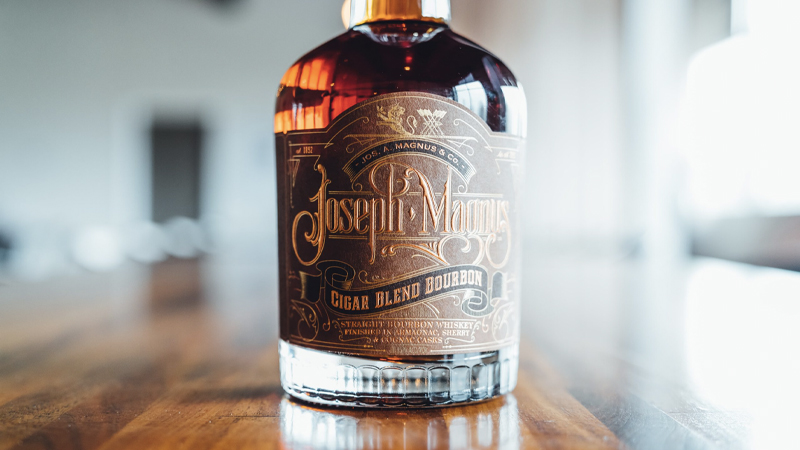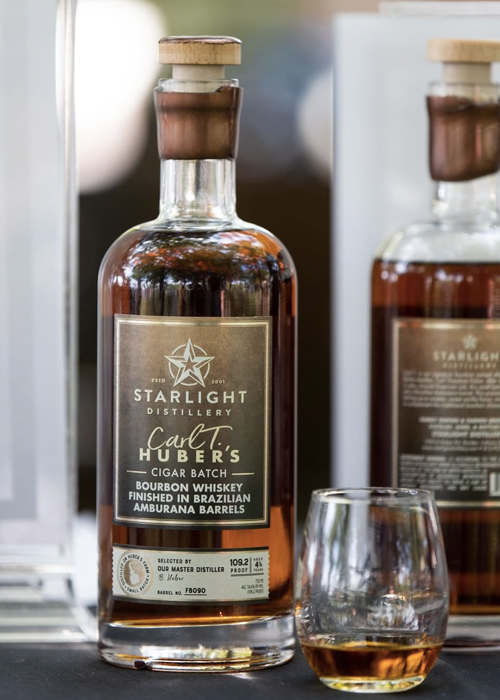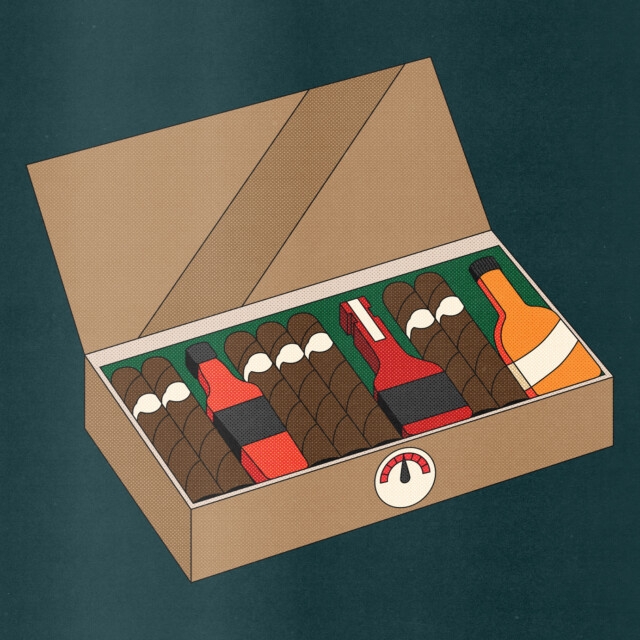“As the creator of it, I can assure you that it was not made up to be a ‘gimmick’ in the least,” Nancy Fraley, master blender at Joseph A. Magnus & Co., told r/bourbon earlier this year.
The subreddit had been debating what exactly a cigar blend, sometimes known as a cigar batch, actually is.
Did it refer to a bourbon meant to taste like a cigar?
Or did it designate a whiskey that will perhaps pair well with a cigar?
Is it just marketing mumbo jumbo?
Whatever the case, the designation seems to be working.
“They sell!” Jimmy Underwood of Good Times Bourbon told me recently about his company’s cigar finishing.
Indeed, you can’t spend any time on bourbon Instagram, Facebook, or Reddit and not encounter the “cigar batch” descriptor these days. At least a half-dozen bourbon companies offer them at the moment, and whiskey collectors scurry to gobble them up, though I doubt most realize the inspiration for them comes from old-world France.
For Lovers of Fine Cigars
Six years ago, Fraley wasn’t thinking about an easy sell like Underwood, she was simply trying to pay homage to her mentor. In the early aughts she had left her career in law to work for Hubert Germain-Robin, one of the country’s original craft distillers. Originally a Cognac maker, he would use his skills to produce brandies in Ukiah, Calif., starting in 1982.
It was at Germain-Robin where Fraley learned about the long tradition of Cognac makers creating “cigare blends,” designed to pair especially well with a stogie. It’s not hard, even today, to find such examples, notably Cognac Frapin Cigar Blend XO, Hine Cognac XO Cigar Reserve, and Cognac Park XO Cigar Blend. By 2001 Germain-Robin would produce Old Havana Alembic Brandy, “for the lover of fine cigars.” (There’s likewise Dalmore Cigar Malt, a single malt Scotch first introduced in 1999.)
“In addition to the age of the eaux-de-vie, brandies that are also distilled on the lees often have a tendency to develop a very elusive yet prized aroma called rancio,” explains Fraley, noting how the word designates an aroma that develops from the oxidized esters of fatty acids and gallic tannins found in the oak. “Over time, it develops notes that are somewhat nutty, earthy, even a little buttery, with some notes of pipe tobacco. Needless to say, this note pairs well with cigars.”
One evening in the spring of 2016, Fraley was sitting on her deck in Berkley, Calif., smoking a pipe when inspiration struck. By then she had become one of the top consultants in the American spirits business, known for her seemingly superhuman sense of smell, which she has used to aid upstarts like Wyoming Whiskey, Virginia Distillery Co., Still Austin Whiskey Co., and Joseph A. Magnus, which had just launched the year before.
“Brandy will always have my heart, but bourbon is my bread and butter,” she says. “I thought I could try to blend one like a cigare blend Cognac.”

At the time, the then-Washington D.C.-based Magnus — today it is located in Holland, Mich. — had an incredible stock of well-aged MGP bourbon. Fraley admits bringing her idea to the brand’s owners, and them having no idea what exactly she was talking about.
“They were thinking I was wanting to do a bourbon-infused cigar,” recalls Fraley. “No, it’s not that! It took a lot of explaining for them to get the whole concept. It still takes a long time for bourbon people to completely understand it.”
A Drug
First released the late summer of 2016, Joseph Magnus Cigar Blend Bourbon would be composed of 11-year-old bourbon and 18-year-old high-rye bourbon finished in sherry, Cognac, and especially Armagnac casks, the older the better, and preferably ones that had formerly held eaux-de-vie made from Baco 22A grapes. Fraley thought those would surely already possess a rancio character that might impart notes of blanched almonds, walnuts, and even blue cheese aromas into the bourbon, along with a rich, full mouthfeel, despite the relatively low 100.7 barrel proof.
Fraley used blending tactics she had learned from her brandy days, creating a truly one-of-a-kind bourbon that offered notes of dark, dried fruits like raisins and dates, vanilla, toffee, spice, leather, and, of course, the bold aroma of tobacco. It was an ideal pairing for the Davidoff Aniversario and Arturo Fuente cigars she favored.
Released in only a few hundred bottles at an MSRP of $200, I remember this distillery and brand that previously no one had heard of, instantly becoming a darling on Facebook’s secondary market, and bottles going for several multipliers of their initial cost.
“Magnus Cigar is a drug to me,” says Caroline Paulus, a whiskey historian with Justin’s House of Bourbon in Louisville and Lexington, Ky. She claims to have tasted around a dozen different batches.
Though Joseph A. Magnus’s overall profile remains fairly unknown among drinkers at large, Cigar Blend continues to be a reliable hit for the brand with connoisseurs — it recently released Batch #92. Today it’s made of 14.5- and 20-year-old Kentucky and Indiana-sourced bourbon.
Even in 2016, the company knew that Fraley had stumbled upon a potentially great marketing idea, with Magnus press materials of the time calling it “possibly the first bourbon post-Prohibition made expressly for” pairing with cigars.
Indeed they were right, and countless imitators have since blossomed.
A Vast Array
At Good Times Bourbon, on its list of custom finishing barrels, among a slew of dessert-leaning flavors like mango brandy and coconut rum, you’ll also see the option to turn anything they own into a cigar finish. For the Frankfort, Ky., brand, that likewise means a blend of Armagnac, Cognac, and sherry barrels — of course, they were inspired by Fraley. (Though, as Fraley admitted to me, she doesn’t use the secondary barrels equally, instead utilizing Armagnac for 95 percent of the finishing profile.)
“It’s a triple barrel process so it’s more time-consuming and more expensive,” says Underwood. Cigar finishing adds approximately $1,000 in costs and six to nine extra months of aging onto any single barrel selection. “When you drink it, it leaves a cigar taste in your mouth,” he says.
So does Buzzard’s Roost Cigar Rye, surely the most on-the-nose of these efforts. Released earlier this year, an entirely new type of barrel was created for the whiskey, with Buzzard’s Roost working with Independent Stave Company to cold-smoke American oak barrels with aged cigar tobacco leaves. MGP’s iconic 95 percent rye is then finished in them. It’s become a buzzy underground hit.
In fact, you can’t stop the hype that currently surrounds the term among extremely online bourbon drinkers. These cigar blends sell no matter who makes them, how old the liquid is, or how expensive they are — even regardless of what barrels they are aged in.
In Borden, Ind., Starlight Distillery finishes its 4½-year-old Carl T. Huber Cigar Batch in Brazilian Amburana barrels, a native hardwood most typically used to age cachaça. (Starlight is the rare distillery that actually distills — as opposed to sources — the whiskey for its cigar batches.)
“When we were deciding to produce a cigar batch bourbon, we wanted to focus on the pairing of a ‘cigar with a bourbon’ rather than focusing on the credentials of other cigar batches in the marketplace already,” explains Christian Huber, a seventh-generation family distiller. “In my opinion, the flavor profile [of cigar batches] will be different from distillery to distillery depending upon the preference of cigars, their mash bills, and whiskey styles.”

His distillery’s release offers notes of spice, cinnamon, and nutmeg. It was well reviewed, even if some critiques thought the labeling wasn’t quite apt.
“[D]on’t be fooled by the ‘Cigar Batch’ label — it’s not close to the same profile as Joseph Magnus’ Cigar Blend (sic),” wrote one blogger, while adding, “and that’s just fine.”
When single barrel bottler Rare Character released its first Cigar Batch in late summer 2022 — in conjunction with the Bourbon Outfitter online store, which also sells branded cigars — it was a rye finished in lightly toasted Amburana barrels. It offers an intense toasted coconut aroma with flavors of what many have described as Cinnamon Toast Crunch milk. (Paulus joking labeled it “Rumchata but make it rye.”)
It, too, tastes nothing like Fraley’s originator, and I have no clue if it’s a great cigar pairing either, but it’s the most interesting American whiskey I’ve had this year and one of the best as well. Nevenglosky agrees that will eventually prove more important than any trendy marketing lingo.
“I know people use the term ‘cigar blend,’ but I would actually argue it has nothing to do with cigars,” says Nevenglosky, though even he can’t help noting that Rare Character’s is delicious with cigars. “It’s maybe not as easy to say it’s an Amburana-finished rye whiskey, but it’s much more true than simply saying it’s a cigar blend.”
And many more of these Rare Character Amburana-finished single barrels are on the way — there’s a waiting list in fact — including a highly anticipated one from the Rhody Barrel Brotherhood, which has a label that simply depicts a Glencairn resting next to a smoking cigar.
Fraley hasn’t tasted any of the other cigar batch releases on the market yet, though she welcomes the trend she started, with slight hesitation.
“My fear is that I don’t want to see these cigar blends become gimmicky,” she says.
“Because it’s not just a marketing gimmick. There’s a long tradition going back to Cognac and the category needs to be respected.”
